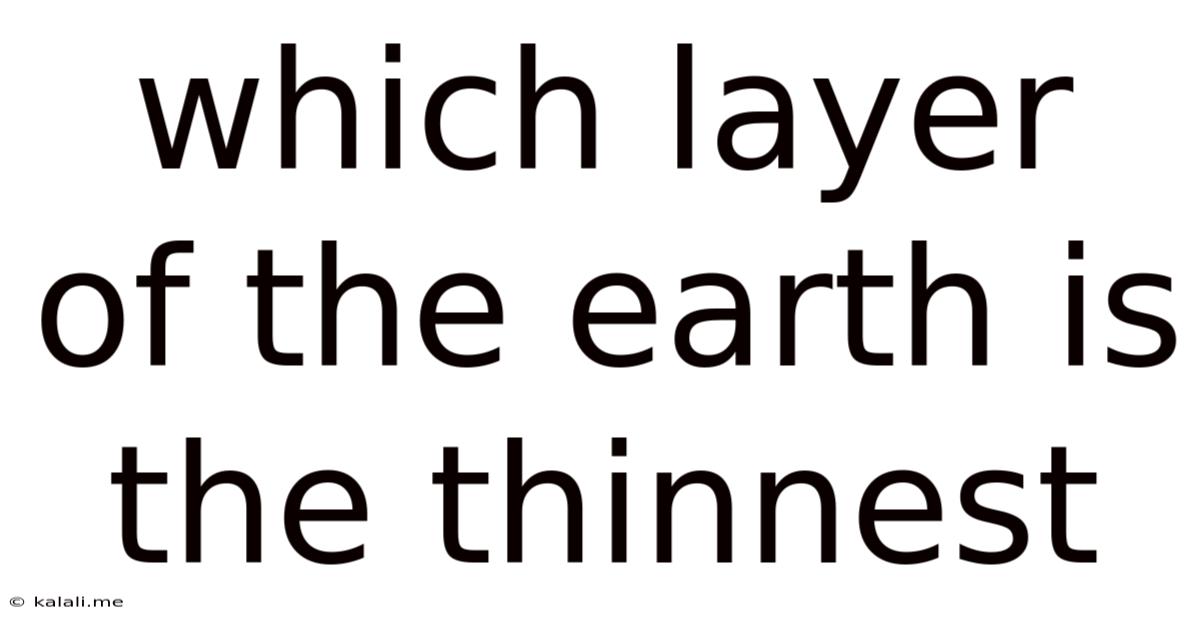Which Layer Of The Earth Is The Thinnest
Kalali
Jun 11, 2025 · 3 min read

Table of Contents
Which Layer of the Earth is the Thinnest? Unveiling the Secrets of Our Planet's Structure
Earth, our vibrant and dynamic home, is a complex system composed of several distinct layers. Understanding these layers is key to grasping the planet's geological processes, from volcanic eruptions to the movement of tectonic plates. But which layer is the thinnest? This article delves into the structure of our planet, revealing the answer and exploring the fascinating characteristics of each layer.
The thinnest layer of the Earth is the crust. This outermost solid shell is significantly thinner than the other layers, varying considerably in thickness depending on location. Think of it as the Earth's delicate skin.
Exploring the Earth's Layers: A Comparative Overview
To understand why the crust is the thinnest, let's compare it to the other layers:
-
Crust: The average thickness of the oceanic crust is approximately 5-10 kilometers (3-6 miles), while the continental crust is thicker, ranging from 30-70 kilometers (19-43 miles). This significant difference is due to the different composition and formation processes of oceanic and continental crust.
-
Mantle: This layer lies beneath the crust and extends to a depth of approximately 2,900 kilometers (1,802 miles). It's significantly thicker than the crust, comprising about 84% of the Earth's volume. The mantle is primarily composed of silicate rocks, exhibiting varying degrees of plasticity and density. Mantle convection, the slow churning movement of the mantle, plays a crucial role in plate tectonics.
-
Outer Core: Located beneath the mantle, the outer core is a liquid layer approximately 2,200 kilometers (1,367 miles) thick. It's primarily composed of iron and nickel, and its swirling motion generates the Earth's magnetic field. This magnetic field protects us from harmful solar radiation.
-
Inner Core: At the Earth's center lies the inner core, a solid sphere with a radius of about 1,220 kilometers (758 miles). The immense pressure at this depth forces the iron and nickel to solidify despite the extremely high temperatures.
Why the Crust is so Thin: A Matter of Formation and Composition
The relative thinness of the Earth's crust is a consequence of its formation and composition. The crust is primarily composed of lighter elements compared to the denser mantle and core. During the Earth's early formation, heavier elements sank towards the center, while lighter materials floated to the surface, forming the crust. This process of differentiation left the crust as the relatively thin outermost layer.
Oceanic vs. Continental Crust: A Tale of Two Crusts
It's also crucial to note that the crust is not uniformly thick. Oceanic crust, found beneath the ocean floor, is thinner and denser than continental crust, which forms the continents. The difference stems from their distinct formation processes and composition. Oceanic crust is primarily basaltic, while continental crust is primarily granitic, resulting in variations in density and thickness.
Conclusion: The Crust – Earth's Delicate Shell
In summary, the Earth's crust is the thinnest layer, a remarkable feat considering its importance in supporting life and shaping the planet's surface. Its thinness, however, makes it particularly vulnerable to geological processes, highlighting the dynamic and ever-changing nature of our planet. Understanding the structure and composition of the Earth's layers provides invaluable insights into the forces that shape our world and the processes that govern its evolution.
Latest Posts
Latest Posts
-
How Many Cups Is 12 Oz Of Chocolate Chips
Jul 01, 2025
-
How Do You Beat Level 7 On Bloxorz
Jul 01, 2025
-
What Grade Level Do You Learn Algebra 1
Jul 01, 2025
-
How Long Ago Was The 16th Century
Jul 01, 2025
-
How Many Inches Are In 4 Yards
Jul 01, 2025
Related Post
Thank you for visiting our website which covers about Which Layer Of The Earth Is The Thinnest . We hope the information provided has been useful to you. Feel free to contact us if you have any questions or need further assistance. See you next time and don't miss to bookmark.